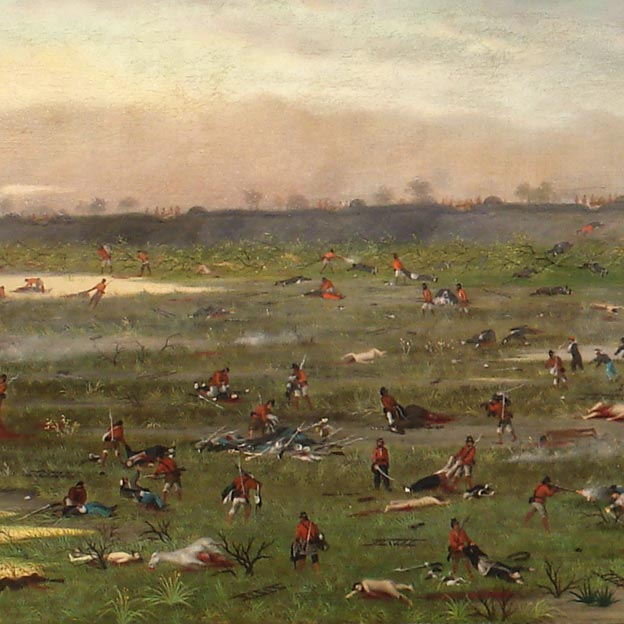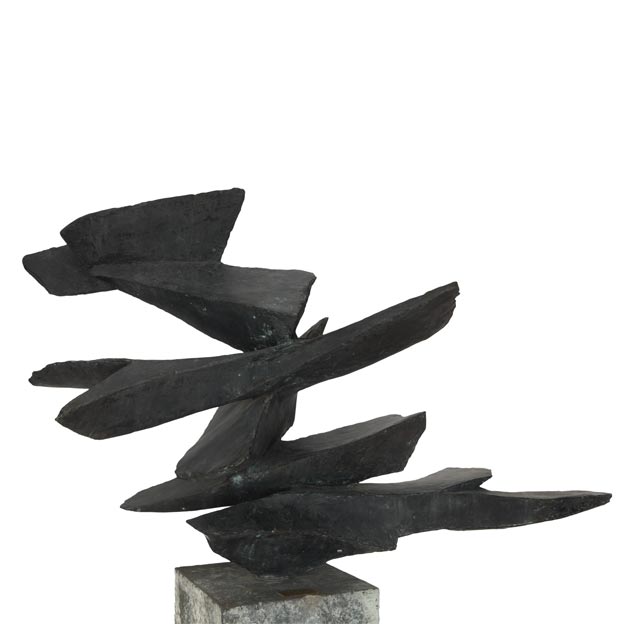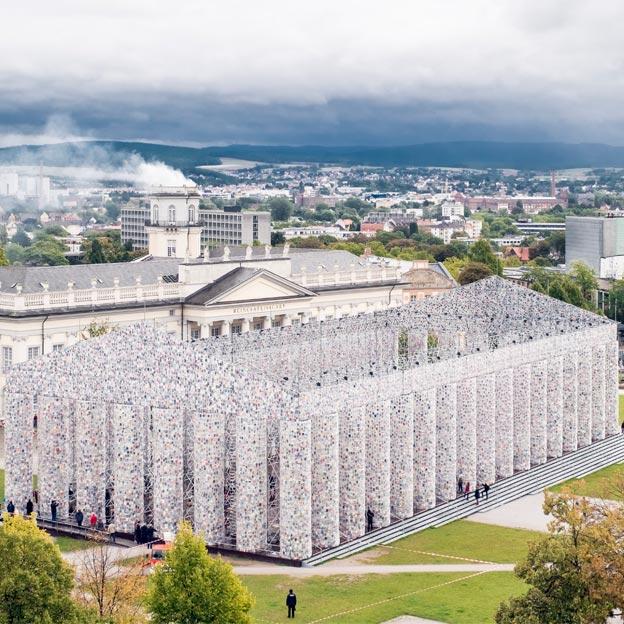

-
“After the Battle of Curupaytí”, 1893.
Cándido López (Argentina, 1840 – 1902)
Oil on canvas, 50,6 x 149,5 cm
Cándido López was a relatively unrecognized artist and painter in his own lifetime, but over the years he has been rediscovered by historians and the Museo Nacional de Bellas Artes owns a series of fifteen paintings that represent one of the Museum’s principal gems.
Cándido López, in addition to being a painter and photographer, was a soldier, who enlisted in the army when Argentina—allied with Brazil and Uruguay—declared war on Paraguay. This campaign was called the Guerra de la Triple Alianza [the War of the Triple Alliance]. The Triple Alliance was comprised of Uruguay, Brazil and Argentina and the war against Paraguay, played out in a series of battles.
During one of the battles, Cándido López suffered a wound from a grenade and lost his right hand, which he had used for drawing and painting. He had to return home from the war and it took him years to learn how to paint with his left hand (not his dominant hand), but he managed to recover and made this series of unique paintings based on the battlefield sketches that he had recorded in situ. Even the painting's format is unique; these are horizontal landscapes that depict events on the battlefield in a highly original way.
The piece, “Después de la batalla de Curupaytí” [After the Battle of Curupaytí] dates from 1893 and depicts the moment after this battle, which was a success for the Paraguayan army. We can see the multiplicity of scenes present in this piece and its many loci of detail. The artist’s choice of rendering the battle’s aftermath—as opposed to its climax—is an interesting one. We can see the wounded, soldiers rescuing their own comrades, a few soldiers finishing off their rivals. In the background and on the horizon, we can make out the trenches and the flag of Paraguay waving in the distance; this is a scene that depicts the dramatic breadth and scope of war, with thousands of men and animals laid waste. The general atmosphere is also quite ominous, the swamplands and the sky covered in smoke from the cannon blasts.

-
“Without Bread and Without Work”, 1894.
Ernesto de la Cárcova (Argentina, 1866 -1927)
Oil on canvas, 125,5 x 216 cm.
The artist Ernesto de la Cárcova played an important role both as an artist and an educator. He was one of the founders of the Escuela Superior de Bellas Artes [Fine Arts Academy], which today bears his name. He studied in Italy, in Turin and Rome. Upon returning from his Italian sojourn, he painted this work in 1894, which is considered the first piece of socially-conscious Argentine art.
Without Bread and Without Work it's a very unusual work, made on a grand scale; it was exhibited in the United States at the 1904 World’s Fair in Saint Louis and won the Grand Prize.
It’s very interesting to note how the artist arranges the composition with one figure looking outwardly—beyond the canvas and towards what’s happening beyond the home—while the female figure is looking down, oblivious to the external situation in a characteristic dichotomy of male and female worlds at the time. The man, outside the home, who brings home bread—in this case with difficulty—and the woman, whose world is limited to the domestic realm, is nursing her baby.
This painting was quite revolutionary in Argentina. It’s been the subject of considerable study and has often been revisited and analyzed, even subject to contemporary revisions, given that its main theme has resurfaced during the different social crises that Argentina has faced over time.

-
“Meteorite”, 1981.
Alicia Penalba (Argentina, 1913 – France, 1982)
Bronze, 140x84x76cm.
Alicia Penalba is another major Argentine artist, though she chiefly pursued her work in Paris, France. She was born in 1913, in San Pedro in the Province of Buenos Aires, and she died in Paris in 1982. She studied at the Escuela de Bellas Artes [School of Fine Arts] in Buenos Aires and then finished her studies at the School of Fine Arts in Paris. Until the 1950’s, she worked as a sculptor and figurative artist, but she abandoned these disciplines after falling in love with abstract form. She was raised in Valparaíso, Chile. Much of her work incorporates elements from the natural world visible in the Chilean landscape; for example, how the Pacific Ocean sculpts the rocks and terrain of Chile.
This piece, called “Meteorito” [Meteorite] was made by the artist a year before her death in 1981 in Paris. This is one of Alicia’s mature pieces, and she always relied on an abstract language to engage with the propositions of abstraction, which is to say, the topics of dynamism, movement, composition, and the work’s material texture, the opacity or texture of the material, sheen—always staying within the parameters that make up the ABC’s of abstract art.

-
“The Parthenon of books”, Buenos Aires 1983 – Kassel, 2017.
Marta Minujín (Argentina, 1943)
Documentary record, books, photography and video.
Marta Minujín is one of Argentina’s most relevant contemporary artists and also enjoys a major international reputation. She has worked, and continues to work, with a variety of media and methods. She paints and draws, and she created installations and happenings early on in Argentina’s contemporary art scene.
One of her paradigmatic works is the “Partenón de libros” [The Parthenon of Books], made in Argentina in 1983 on one of Buenos Aires’s major avenues during the year that democracy was restored in our country. Argentina underwent a series of coups d’états and military dictatorships. The last of these occurred in 1976 and ended in 1983. That same year, Minujín presented this public and ephemeral work that consisted in constructing a massive Parthenon, similar to the Greek Parthenon, with a scaffolding of pipes whose columns and walls were covered with books that had been banned during the military dictatorship.
This was an historic, paradigmatic work in Argentina and the subject of significant study; it produced a series of videos, documents and photographs. In 2017, Marta Minujín was invited to the Kassel Documenta—one of the contemporary art world’s most important events—to recreate the “Partenón de libros”, this time in the German city of Kassel.
At the Museo Nacional de Bellas Artes, we have several documentary artifacts of these two events: the 1983 “Partenón” and it's 2017 interaction. These objects were donated by artist herself and are comprised of photographs, videos and books that were part of both the 1983 and the 2017 “Partenón”. This donation, made with great generosity by Marta Minujín to the Museo Nacional de Bellas Artes, was offered within the framework of a prize that she received in 2019 for her lifetime achievement as an artist.
